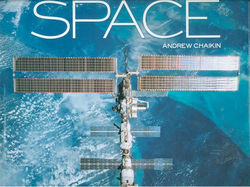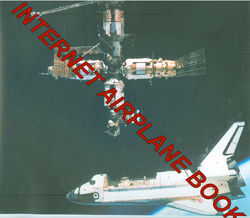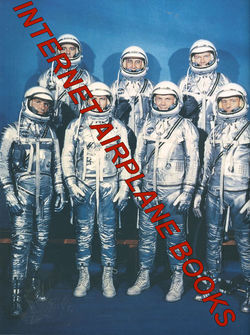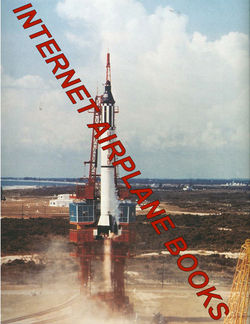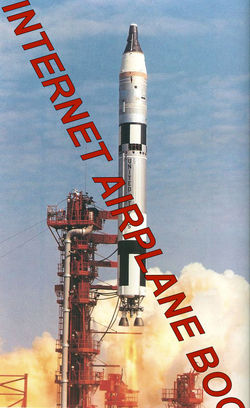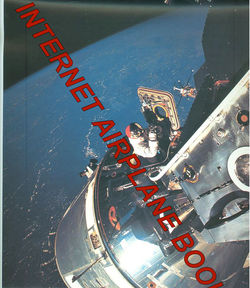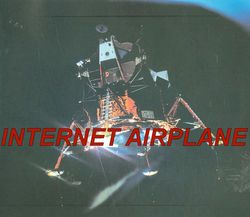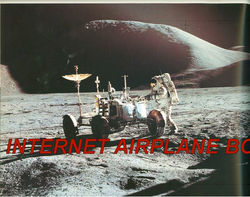SPACE HBDJ MERCURY GEMINI APOLLO
SKYLAB SOYUZ ARIANE SALYUT SPACE SHUTTLE MIR ISS
HARDBOUND BOOK with DUSTJACKET by ANDREW CHAIKIN (250 PAGES)
FOREWORD BY CAPTAIN JAMES LOVELL OF APOLLO 8 & APOLLO
13
SPUTNIK, VANGUARD, X-15, COSMONAUTS, YURI GAGARIN,
VALENTINA TERESHKOVA
LUNA & SURVEYOR
SOYUZ
PROJECT MERCURY (ALAN SHEPARD, VIRGIL “GUS” GRISSOM,
WALLY SHIRRA, DEKE SLAYTON, JOHN GLENN, SCOTT CARPENTER, GORDON COOPER,
MERCURY-REDSTONE, FREEDOM 7, LIBERTY BELL 7, FRIENDSHIP 7, MERCURY-ATLAS,
AURORA 7, SIGMA 7, FAITH 7)
PROJECT GEMINI (GEMINI V, GEMINI VI, PETE CONRAD, JOHN
YOUNG, EDWARD WHITE, JAMES McDIVITT, “MOLLY BROWN”, FLIGHT DIRECTOR CHRIS
KRAFT, FRANK BORMAN, JIM LOVELL, THOMAS STAFFORD, DAVID SCOTT, AGENA TARGET
VEHICLE, GEMINI IX, EUGENE CERNAN, GEMINI X, RICHARD GORDON, GEMINI XII, BUZZ
ALDRIN)
PROJECT APOLLO (SATURN V BOOSTER, LUNAR MODULE, KENNEDY
SPACE CENTER, APOLLO 1, ROGER CHAFFEE, APOLLO 7 SHIRRA, APOLLO 8 BORMAN LOVELL
WILLIAM ANDERS, APOLLO 9 SCOTT McDIVITT SCHWEICKART, APOLLO 10 YOUNG CERNAN
STAFFORD, APOLLO 11 MICHAEL COLLINS NEIL ARMSTRONG BUZZ ALDRIN, APOLLO 12 PETE
CONRAD, ALAN BEAN RICHARD GORDON, APOLLO 13 LOVELL SWIGERT HAISE MATTINGLY,
APOLLO 14 SHEPARD EDGAR MITCHELL STUART ROOSA, APOLLO 15 SCOTT ALFRED WORDEN,
APOLLO 16 YOUNG MATTINGLY CHARLES DUKE, APOLLO 17 CERNAN HARRISON SCHMITT
RONALD EVANS, APOLLO-SOYUZ, SKYLAB)
SALYUT & MIR SPACE STATIONS
RUSSIAN N-1 BOOSTER
BAIKONUR COSMODROME IN KAZAKHSTAN
VENERA LANDER
MARS VIKING LANDER
VOYAGER
SOVIET UNION SPACE SHUTTLE BURAN
SPACE SHUTTLE (ENTERPRISE, COLUMBIA, ENDEAVOR, DISCOVERY,
CHALLENGER)
EUROPEAN SPACE AGENCY ARIANE BOOSTER
INTERNATIONAL SPACE STATION “FREEDOM” ISS
---------------------------------------------------------------------------------------------------------
Additional Information from Internet Encyclopedia
Vostok (Russian Восток, translated as "East")
was a family of rockets derived from the Soviet R-7 Semyorka ICBM designed for
the human spaceflight programme. This family of rockets launched the first
artificial satellite (Sputnik 1) and the first manned spacecraft (Vostok) in
human history. It was a subset of the R-7 family of rockets.
On March 18, 1980 a Vostok-2M rocket exploded on its
launch pad at Plesetsk during a fueling operation, killing 48 people. An
investigation into a similar – but avoided – accident revealed that the
substitution of lead-based for tin-based solder in hydrogen peroxide filters
allowed the breakdown of the H2O2, thus causing the resultant explosion.
Vostok 1 (Russian: Восто́к-1, East 1 or Orient 1) was the
first spaceflight of the Vostok programme and the first manned spaceflight in
history. The Vostok 3KA space capsule was launched on April 12, 1961 from
Baikonur Cosmodrome with Soviet cosmonaut Yuri Gagarin, making him the first
human to cross into outer space.
The orbital spaceflight consisted of a single orbit
around Earth which skimmed the upper atmosphere at 169 kilometers (91 nautical
miles) at its lowest point. The flight took 108 minutes from launch to landing.
Gagarin parachuted to the ground separately from his capsule after ejecting at
7 km (23,000 ft) altitude.
The Space Race between the Soviet Union and the United
States, the two Cold War superpowers, began just before the Soviet Union
launched the world's first artificial satellite, Sputnik 1, in 1957. Both
countries wanted to develop spaceflight technology quickly, particularly by
launching the first successful human spaceflight. The Soviet Union secretly
pursued the Vostok programme in competition with the United States Project
Mercury. Vostok launched several precursor unmanned missions between May 1960
and March 1961, to test and develop the Vostok rocket family and space capsule.
These missions had varied degrees of success, but the final two—Korabl-Sputnik
4 and Korabl-Sputnik 5—were complete successes, allowing the first manned flight.
The Vostok 1 capsule was designed to carry a single
cosmonaut. Yuri Gagarin, 27, was chosen as the prime pilot of Vostok 1, with
Gherman Titov and Grigori Nelyubov as backups. These assignments were formally
made on April 8, four days before the mission, but Gagarin had been a favourite
among the cosmonaut candidates for at least several months.
The final decision of who would fly the mission relied
heavily on the opinion of the head of cosmonaut training, Nikolai Kamanin. In
an April 5 diary entry, Kamanin wrote that he was still undecided between
Gagarin and Titov. "The only thing that keeps me from picking [Titov] is
the need to have the stronger person for the one day flight." Kamanin was
referring to the second mission, Vostok 2, compared to the relatively short
single-orbit mission of Vostok 1. When Gagarin and Titov were informed of the
decision during a meeting on April 9, Gagarin was very happy, and Titov was
disappointed. On April 10, this meeting was reenacted in front of television
cameras, so there would be official footage of the event. This included an
acceptance speech by Gagarin. As an indication of the level of secrecy
involved, one of the other cosmonaut candidates, Alexei Leonov, later recalled
that he did not know who was chosen for the mission until after the spaceflight
had begun.
On Baikonur Cosmodrome on the morning of April 11, 1961,
the Vostok-K rocket, together with the attached Vostok 3KA space capsule, were
transported several kilometers to the launch pad, in a horizontal position.
Once they arrived at the launch pad, a quick examination of the booster was
conducted by technicians to make sure everything was in order. When no visible
problems were found, the booster was erected on LC-1. At 10:00 (Moscow Time),
Gagarin and Titov were given a final review of the flight plan. They were
informed that launch was scheduled to occur the following day, at 09:07 Moscow
Time. This time was chosen so that when the capsule started to fly over Africa,
which was when the retrorockets would need to fire for reentry, the solar
illumination would be ideal for the orientation system's sensors.
At 18:00, once various physiological readings had been
taken, the doctors instructed the cosmonauts not to discuss the upcoming
missions. That evening Gagarin and Titov relaxed by listening to music, playing
pool, and chatting about their childhoods. At 21:50, both men were offered
sleeping pills, to ensure a good night's sleep, but they both declined.
Physicians had attached sensors to the cosmonauts, to monitor their condition
throughout the night, and they believed that both had slept well. Gagarin's
biographers Doran and Bizony say that neither Gagarin nor Titov slept that
night. Korolev didn't sleep that night, due to anxiety caused by the imminent spaceflight.
At 05:30 Moscow time, on the morning of April 12, 1961,
both Gagarin and his backup Titov were woken.[22] They were given breakfast,
assisted into their spacesuits, and then were transported to the launch
pad.[23] Gagarin entered the Vostok 1 spacecraft, and at 07:10 local time
(04:10 UTC), the radio communication system was turned on.[23] Once Gagarin was
in the spacecraft, his picture appeared on television screens in the launch
control room from an onboard camera. Launch would not occur for another two
hours, and during the time Gagarin chatted with the mission's main CapCom, as
well as Chief Designer Sergei Korolev, Nikolai Kamanin, and a few others.
Following a series of tests and checks, about forty minutes after Gagarin
entered the spacecraft, its hatch was closed. Gagarin, however, reported that
the hatch was not sealed properly, and technicians spent nearly an hour
removing all the screws and sealing the hatch again. According to a 2014
obituary, Vostok's chief designer, Oleg Ivanovsky, personally helped rebolt the
hatch. There is some disagreement over whether the hatch was in fact not sealed
correctly, as a more recent account stated the indication was false.
During this time Gagarin requested some music to be
played over the radio. Korolev was suffering from chest pains and close to a
nervous breakdown. This was the 24th Soviet space launch and the 16th involving
a Luna/Vostok booster. So far, 12 launches had failed, for a success rate of
exactly 50%. Two Vostoks had failed to reach orbit due to launch vehicle
malfunctions and another two malfunctioned in orbit. Korolev was given a pill
to calm him down. Gagarin, on the other hand, was described as calm; about half
an hour before launch his pulse was recorded at 64 beats per minute.
At 07:25 UT, the spacecraft's automatic systems brought
it into the required attitude (orientation) for the retrorocket firing, and
shortly afterwards, the liquid-fueled engine fired for about 42 seconds over
the west coast of Africa, near Angola, about 8,000 kilometers (4,300 nautical
miles) uprange of the landing point. The orbit's perigee and apogee had been
selected to cause reentry due to orbital decay within 10 days (the limit of the
life support system function) in the event of retrorocket malfunction. However,
the actual orbit differed from the planned and would not have allowed descent
until 20 days.
Ten seconds after retrofire, commands were sent to
separate the Vostok service module from the reentry module (code name sharik,
"little ball"), but the equipment module unexpectedly remained
attached to the reentry module by a bundle of wires. At around 07:35 UT, the
two parts of the spacecraft began reentry and went through strong gyrations as
Vostok 1 neared Egypt. At this point the wires broke, the two modules
separated, and the descent module settled into the proper reentry attitude.
Gagarin telegraphed "Everything is OK" despite continuing gyrations;
he later reported that he did not want to "make noise" as he had
(correctly) reasoned that the gyrations did not endanger the mission (and were
apparently caused by the spherical shape of the reentry module). As Gagarin
continued his descent, he remained conscious as he experienced about 8 g during
reentry. (Gagarin's own report states "over 10 g".)
At 07:55 UT, when Vostok 1 was still 7 km from the
ground, the hatch of the spacecraft was released, and two seconds later Gagarin
was ejected. At 2.5 km (8,200 ft) altitude, the main parachute was deployed
from the Vostok spacecraft. Two schoolgirls witnessed the Vostok landing and
described the scene: "It was a huge ball, about two or three meters high.
It fell, then it bounced and then it fell again. There was a huge hole where it
hit the first time."[citation needed]
Gagarin's parachute opened almost right away, and about
ten minutes later, at 08:05 UT, Gagarin landed. Both he and the spacecraft
landed via parachute 26 km (16 mi) south west of Engels, in the Saratov region
It was 280 km to the west of the planned landing site (near Baikonur).
A farmer and her daughter observed the strange scene of a
figure in a bright orange suit with a large white helmet landing near them by
parachute. Gagarin later recalled, "When they saw me in my space suit and
the parachute dragging alongside as I walked, they started to back away in
fear. I told them, don't be afraid, I am a Soviet citizen like you, who has
descended from space and I must find a telephone to call Moscow!"
Gagarin's flight was announced on the Soviet radio by
Yuri Levitan, the speaker who had announced all major events in the Great
Patriotic War (WW2). As with all previous and most subsequent Soviet rocket
launches, the flight preparation was kept secret and the news was aired only
post-factum. The flight was celebrated as a great triumph of the Soviet science
and technology demonstrating the superiority of the socialist system over
capitalism. Moscow and other cities in the USSR held mass demonstrations, the
scale of which was comparable to World War II Victory Parades. Gagarin was
awarded the title of Hero of the Soviet Union, the nation's highest honour. He
also became an international celebrity with numerous honours and awards.
April 12 was declared Cosmonautics Day in the USSR, and
is celebrated today in Russia as one of the official "Commemorative Dates
of Russia." In 2011, it was declared the International Day of Human Space
Flight by the United Nations.
Gagarin's informal reply poyekhali! became a historical
phrase used to refer to the arrival of the Space Age in human history. Later it
was included in the refrain of a Soviet patriotic song written by Alexandra
Pakhmutova and Nikolai Dobronravov (He said "let's go!" He waved his
hand).
The Soviet press later reported that, minutes before
boarding the spacecraft, Gagarin made a speech: "Dear friends, you who are
close to me, and you whom I do not know, fellow Russians, and people of all
countries and all continents: in a few minutes a powerful space vehicle will
carry me into the distant realm of space. What can I tell you in these last
minutes before the launch? My whole life appears to me as one beautiful moment.
All that I previously lived through and did, was lived through and done for the
sake of this moment." According to historian Asif Siddiqi, Gagarin
actually "was essentially forced to utter a stream of banalities prepared
by anonymous speechwriters" taped much earlier in Moscow.



